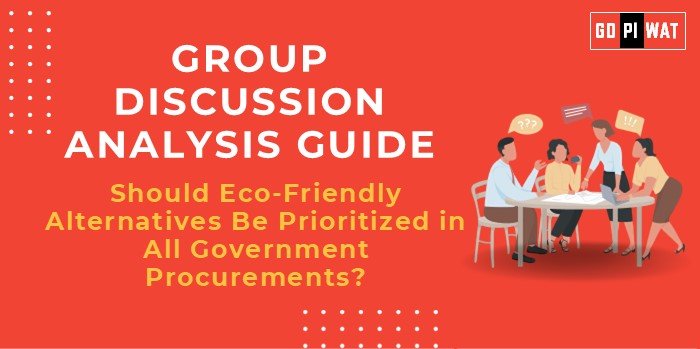🌱 Group Discussion (GD) Analysis Guide
Should Eco-Friendly Alternatives Be Prioritized in All Government Procurements?
💡 Introduction to the Topic
- Context Setting: Governments worldwide are under increasing pressure to combat climate change and adopt sustainable practices. Making eco-friendly alternatives mandatory in procurement is a significant step towards achieving sustainability goals.
- Background: Government procurements contribute significantly to national expenditures. Incorporating eco-friendly alternatives not only reduces environmental impact but also drives innovation in green technologies. Many nations, such as Sweden and Japan, have adopted similar approaches to align with their climate commitments.
📊 Quick Facts and Key Statistics
- Global Procurement Value: Public procurement accounts for 12% of GDP in OECD countries, indicating its potential to drive market demand.
- Greenhouse Gas Emissions: Procurement of construction materials contributes to 15% of global emissions.
- India’s Commitment: Targeting net-zero emissions by 2070, with renewable energy forming 50% of its energy capacity by 2030.
- Budget Impact: Green alternatives often cost 10-30% more upfront but save operational costs in the long term.
👥 Stakeholders and Their Roles
- Government Agencies: Mandate and enforce eco-friendly policies in procurement processes.
- Private Companies: Innovate and supply sustainable alternatives.
- Citizens: Advocate for accountability in eco-friendly commitments.
- International Organizations: Provide frameworks, e.g., UN’s Sustainable Procurement Goals.
🏆 Achievements and Challenges
- Achievements:
- Economic Growth via Green Jobs: Countries like Germany saw a 25% increase in green jobs post-adoption of eco-friendly procurement policies.
- Carbon Footprint Reduction: Transitioning to green materials in infrastructure projects reduced emissions by 20% in Norway.
- Innovation Boost: Demand for sustainable solutions has led to breakthroughs in recyclable materials and renewable technologies.
- Challenges:
- Cost Barriers: Higher initial investments deter adoption.
- Vendor Readiness: Limited suppliers meet eco-certifications, especially in developing economies.
- Policy Implementation Gaps: Enforcement of green procurement is inconsistent across regions.
🌍 Global Comparisons
- Sweden’s Green Procurement Policy: Mandates lifecycle cost analysis, ensuring economic and environmental benefits.
- Case Study: Kerala, India, has successfully integrated sustainable materials in public projects, achieving cost savings and reducing environmental impact.
📋 Structured Arguments for Discussion
- Supporting Stance: “Prioritizing eco-friendly alternatives aligns with long-term economic and environmental goals, fostering innovation and reducing carbon emissions.”
- Opposing Stance: “Higher costs and limited supplier readiness may impede implementation, especially in developing economies.”
- Balanced Perspective: “While eco-friendly procurement has challenges, phased adoption with government incentives can mitigate barriers.”
📖 Effective Discussion Approaches
- Opening Approaches:
- Data-driven: “Public procurement forms 12% of GDP; transitioning to green alternatives could significantly reduce emissions.”
- Contrast: “While eco-friendly options are expensive upfront, lifecycle savings outweigh costs.”
- Real-world examples: “Kerala’s green initiatives showcase cost savings and reduced environmental impact.”
- Counter-Argument Handling:
- Highlight lifecycle savings to address cost concerns.
- Advocate for phased implementation to ease vendor readiness.
🔍 Strategic Analysis of Strengths and Weaknesses
- Strengths: Reduces environmental footprint, drives innovation, and supports climate goals.
- Weaknesses: Higher initial costs, supply chain constraints.
- Opportunities: Green technology advancements, international collaborations.
- Threats: Resistance from stakeholders, lack of awareness.
📚 Connecting with B-School Applications
- Real-World Applications: Topics for case studies in supply chain management and sustainability.
- Sample Interview Questions:
- “How can India overcome cost barriers in green procurement?”
- “What role do public-private partnerships play in advancing sustainable procurement?”
- Insights for B-School Students: Understand lifecycle costing, develop sustainability frameworks, and explore vendor management strategies.


